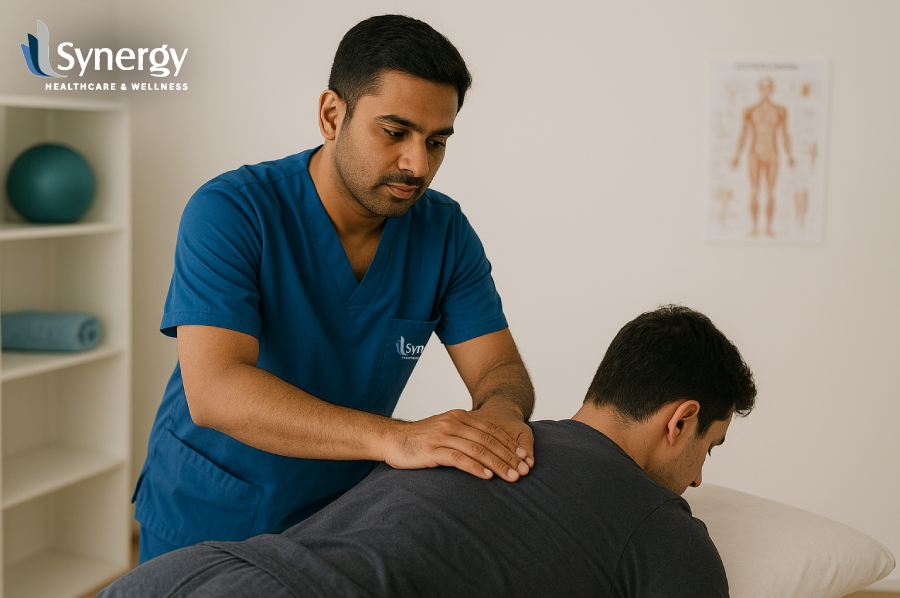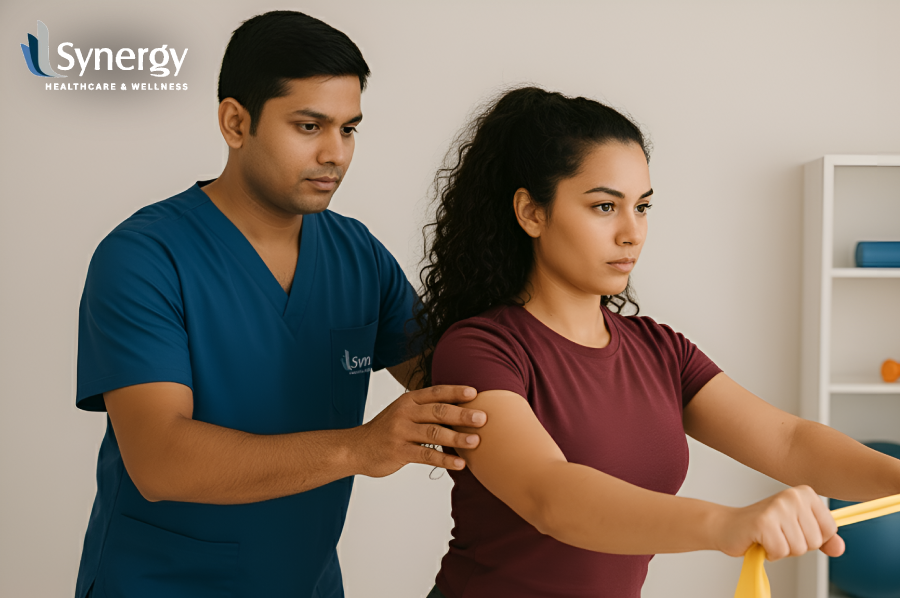When pain begins to restrict movement, affect sleep, or intrude into daily life, it is natural to look for relief swiftly. Many reach for medications or quick fixes. Yet, for lasting benefit and fewer side effects, Physiotherapy For Pain Relief stands out as a premier option. In a city like Chennai, where urban life, traffic, sedentary jobs, and ageing structures converge, physiotherapy offers a path toward recovery that is both effective and humane.
Understanding Pain: More Than Just a Symptom
Pain is not merely a signal of injury; it is a multifaceted experience involving tissues, nerves, behaviour, and psychology. Chronic pain often sets up a vicious cycle: discomfort leads to guarding or reduced movement, which weakens muscles and stiffens joints, increasing pain in turn. Physiotherapy addresses this cycle rather than just masking symptoms.
Many forms of pain are musculoskeletal or neuromuscular in origin: back pain, neck pain, joint stiffness, arthritis, tendon problems, and postural strain. These are precisely the types of issues physiotherapists specialise in treating.
By assessing posture, movement patterns, muscle imbalances, joint restriction, and nerve sensitivity, physiotherapists can identify root contributors to pain, not just the superficial “hurt spot.”
Thus, physiotherapy has the potential to correct underlying dysfunctions and prevent recurrence.
Core Benefits of Physiotherapy for Pain Relief
Below are the principal advantages that make physiotherapy a preferred option for pain management.
1. Non-invasive, low-risk treatment
Physiotherapy is a non-surgical, drug-sparing intervention. It avoids many risks associated with long-term medication (such as gastrointestinal, renal, or cardiovascular side effects) and complications of surgery.
2. Pain modulation through movement and techniques
Gentle mobilisation, stretching, manipulations, or soft tissue techniques help reduce stiffness, improve joint glide, and relax overactive muscles. These manual and movement-based methods stimulate blood flow, reduce inflammation, and interrupt pain signals. Electrotherapies (such as ultrasound, TENS, and laser) may be used adjunctively to reduce pain and promote healing in some cases.
3. Structured exercise to build strength, flexibility, and stability
A physiotherapist prescribes a tailored exercise plan targeting weak, tight, or imbalanced muscles. Over time, this enhances joint support, restores movement, and reduces mechanical stress that leads to pain.
4. Retraining the nervous system in chronic pain
With long-standing pain, the nervous system can become hypersensitive, interpreting even mild stimuli as harmful. Physiotherapists use “graded exposure,” desensitisation techniques, and neuromuscular reeducation to calm this sensitivity. Through controlled movement and progressive loading, patients reclaim confidence and reduce fear-avoidant behaviours.
5. Preservation of function and prevention of recurrence
Rather than just quelling pain when it appears, physiotherapy aims to maintain mobility, strength, and posture to prevent future flare-ups. In the context of Chennai’s climate, commuting, and lifestyle, regular physiotherapy adjustments may help with ergonomic alignment, postural awareness, and daily activity adaptation.
6. Holistic benefits: mood, sleep, and quality of life
Pain often causes or worsens anxiety, depression, or sleep disturbances. As pain reduces and function improves, mood and sleep follow suit. Many patients report greater well-being, energy, and capacity to engage in meaningful daily life. This holistic uplift is often underappreciated but is central to sustainable recovery.
Common Pain Conditions in Chennai That Respond Well to Physiotherapy
Here are a few examples of pain problems often encountered locally and how physiotherapy helps:
1. Lower back pain/sciatica
One of the most frequent complaints. Physiotherapy combines spinal mobilisation, core stabilisation exercises, decompressing techniques, and neural mobilisation (nerve glides) to reduce nerve irritation and restore function.
In Chennai, many lower back problems stem from prolonged sitting, lack of exercise, or poor seating ergonomics; a physiotherapist can correct posture, recommend ergonomic adjustments, and guide exercises suited to local constraints (e.g., cramped workspaces).
2. Neck pain / cervical discomfort
From smartphone usage to desk jobs, many present with neck stiffness or radiculopathy. Physiotherapy uses traction, soft tissue release, postural reeducation, and stabilisation exercises to reduce compression and restore mobility.
3. Knee pain/osteoarthritis
Strengthening the muscles around the knee, improving the flexibility of surrounding structures, and correcting gait mechanics are powerful non-surgical strategies to relieve pain, delay degeneration, and reduce stress on joint surfaces.
4. Shoulder pain / frozen shoulder (adhesive capsulitis)
Early mobilisation, controlled stretching, and joint techniques can prevent long-term restriction. Studies show that movement guided by physiotherapy leads to better outcomes in range and pain when compared to immobilisation.
5. Post-surgery rehabilitation/injuries
After orthopaedic surgeries (like joint replacement or ligament repair), physiotherapy is indispensable to restore strength, mobility, stability, and safe function. Without it, outcomes are poorer.
What to Expect in a Physiotherapy Programme in Chennai
A well-structured physiotherapy programme typically unfolds in stages; the patient is guided closely throughout.
- Comprehensive assessment
The therapist will evaluate posture, movement patterns, muscle strength, joint range, flexibility, gait, and neurological signs. Detailed history reveals onset, aggravating factors, and lifestyle issues. - Goal setting and patient education
Clear, realistic goals are set (e.g., walking pain-free, returning to work, sleeping without discomfort). Education about pain mechanisms, posture, self-management, and behavioural change forms a core component. - Intervention phase
- Manual techniques and mobilisation
- Soft tissue release, myofascial work
- Modalities (heat, ultrasound, TENS)
- Therapeutic exercises: stretching, strengthening, core work
- Neuromuscular re-education and movement retraining
- Functional and activity-based tasks tailored to daily life
- Manual techniques and mobilisation
- Home programme and self-management
The bulk of recovery comes from regular home exercises, posture correction, and adherence to guidance. The therapist provides a structured plan that fits local constraints (space, time, equipment). - Monitoring, progression, and prevention
Progress is tracked; exercises are advanced. Prevention strategies — ergonomic advice, lifestyle adjustments, periodic checkups — are emphasised to prevent relapse.
Overcoming Common Misconceptions
- “Physiotherapy is just massages and rubbing.”
Rather, it is a science-based, evidence-driven practice combining movement, manual therapy, education, and progressive load. - “It will take too long or may not work.”
While recovery time depends on severity and chronicity, many patients begin seeing improvement within weeks. Persistence and compliance matter. - “Surgery is quicker, so why wait?”
Surgery is often necessary in a minority of cases. For many musculoskeletal conditions, conservative physiotherapy achieves similar or superior outcomes without operative risks. - “It’s expensive to go frequently.”
The early investment often pays dividends by reducing medication costs, imaging, injections, or future interventions.
Why Trust Synergy?
At Synergy, our reputation as a trusted pain relief and physiotherapy centre in Chennai is built on substance and consistent results.
Clinical Expertise: Our therapists are qualified and experienced in musculoskeletal, neurological, and pain management rehabilitation. Each case is handled with professional precision and personal attention.
Evidence-Based Practice: Every treatment follows tested, research-backed methods. Programmes are individually designed to address the root cause rather than only the symptoms.
Whole-Person Care: We treat movement, mind, and lifestyle as connected parts of recovery. Education, awareness, and mental wellness are integrated into every stage of care.
Modern and Responsible Treatment: We use advanced physiotherapy equipment and modalities where they are genuinely beneficial, under disciplined clinical supervision.
Accountability and Follow-Up: Progress is measured, reviewed, and refined through clear feedback systems. Our patients remain supported well beyond the treatment phase.
Education and Empowerment: We help each patient understand their condition, build confidence in movement, and maintain long-term self-management.
Final Thoughts
Pain often sends a warning signal, but how it is addressed determines whether it becomes a chronic adversary. Physiotherapy offers a coherent, holistic, scientifically grounded path — one that treats the person, not just the symptom.
In Chennai, where the tensions of urban life, weather, and work habits add strain, physiotherapy is more than a fallback — it should be the first thoughtful choice. When pain arises, seeking physiotherapy early offers better outcomes, fewer complications, lower cost burden, and a return to an active, comfortable life.
If readers question “Why Physiotherapy Is Best for Pain,” the answer lies in its capacity to heal without harm, to correct rather than mask, and to restore function rather than only suppress discomfort. For pain relief in Chennai, physiotherapy deserves a prime place.
FAQs
1. Why is physiotherapy considered the best option for pain relief in Chennai?
Physiotherapy offers long-term relief without the side effects associated with medication or surgery. It focuses on restoring function, mobility, and balance by addressing the underlying causes of pain rather than masking symptoms. In Chennai, where lifestyle and posture-related pain are everyday, physiotherapy provides a safe, scientific, and sustainable path to recovery.
2. What types of pain can physiotherapy treat?
Physiotherapy effectively manages back pain, neck pain, arthritis, knee pain, frozen shoulder, sciatica, tendon injuries, postural strain, and pain following surgery or accidents. Therapists assess movement patterns and muscle function to create targeted recovery plans.
3. How soon can I expect results from physiotherapy?
Improvement varies depending on the condition’s severity and duration. Many patients notice reduced pain and better movement within two to three weeks of consistent treatment and home exercise. Chronic or post-surgical cases may require longer, structured programmes.
4. Is physiotherapy suitable for chronic pain?
Yes. Chronic pain often involves changes in how the brain and nerves process signals. Physiotherapy uses graded movement, desensitisation, and retraining to calm this sensitivity, helping patients regain confidence and restore normal function.
5. Does physiotherapy replace medication or surgery?
In many cases, physiotherapy can reduce or eliminate the need for painkillers and delay or avoid surgery altogether. When surgery is unavoidable, physiotherapy plays a crucial role before and after the procedure to improve outcomes and prevent complications.












